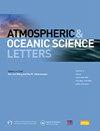未来厄尔尼诺/南方涛动调制增强时陆地碳吸收变化的增加
IF 3.2
4区 地球科学
Q3 METEOROLOGY & ATMOSPHERIC SCIENCES
引用次数: 0
摘要
El Niño-Southern涛动(ENSO)是中低纬度地区气候变化的主要驱动因素,通过陆气相互作用对陆地碳循环产生强烈影响。预计ENSO调制和碳通量变率在未来都将增加,但它们之间的联系仍需要进一步研究。为探讨未来ENSO调制对碳通量变率的影响,本研究利用10个CMIP6地球系统模式,分析了不同情景下ENSO调制与中低纬度地区碳通量变率的关系。模拟结果显示出较高的一致性,ENSO调制和碳通量变率在未来都呈现出增加的趋势。排放情景越高,特别是SSP5-8.5与SSP2-4.5相比,变率的增加越大。1951-2000年,在SSP2-4.5条件下,中低纬度地区的碳通量变率比历史水平增加了30.9%,而在SSP5-8.5条件下,碳通量变率增加了58.2%。进一步分析表明,ENSO主要通过温度影响中低纬度碳通量变率。这种现象可能归因于总初级生产力对区域温度波动的响应性增强,以及ENSO对陆地表面温度的影响加剧。。本研究基于10个CMIP6地球系统模式,分析了不同情景下ENSO变率与中低纬度地区总初级生产力变率的关系。“”“”“”“”“”“”在未来情境下(2051 - 2100年),中低纬度地区的总初级生产力变率较历史时期(1951 - 2000年)增加了30.9% (ssp2 - 4.5)、58.2% (ssp5 - 8.5)。http://www.tingclass.ac.cn/cn/或http://www.tingclass.ac.cn/cn/中文意思是:“我的意思是我的意思是我的意思是我的意思是我的意思是我的意思。”本文章由计算机程序翻译,如有差异,请以英文原文为准。
Increase in the variability of terrestrial carbon uptake in response to enhanced future ENSO modulation
El Niño–Southern Oscillation (ENSO) is a major driver of climate change in middle and low latitudes and thus strongly influences the terrestrial carbon cycle through land–air interaction. Both the ENSO modulation and carbon flux variability are projected to increase in the future, but their connection still needs further investigation. To investigate the impact of future ENSO modulation on carbon flux variability, this study used 10 CMIP6 earth system models to analyze ENSO modulation and carbon flux variability in middle and low latitudes, and their relationship, under different scenarios simulated by CMIP6 models. The results show a high consistency in the simulations, with both ENSO modulation and carbon flux variability showing an increasing trend in the future. The higher the emissions scenario, especially SSP5-8.5 compared to SSP2-4.5, the greater the increase in variability. Carbon flux variability in the middle and low latitudes under SSP2-4.5 increases by 30.9% compared to historical levels during 1951–2000, while under SSP5-8.5 it increases by 58.2%. Further analysis suggests that ENSO influences mid- and low-latitude carbon flux variability primarily through temperature. This occurrence may potentially be attributed to the increased responsiveness of gross primary productivity towards regional temperature fluctuations, combined with the intensified influence of ENSO on land surface temperatures.
摘要
ENSO是中低纬度地区气候系统的主要驱动因素, 对陆地碳循环有重要影响. 本研究基于10个CMIP6地球系统模式, 分析了不同情景下ENSO变率与中低纬度地区总初级生产力变率的关系. 结果显示, 未来ENSO变率和总初级生产力变率在未来多数模式均显示为增加. 在未来情境下(2051-2100年), 中低纬度地区的总初级生产力变率较历史时期(1951–2000年)增加了30.9%(SSP2-4.5), 58.2%(SSP5-8.5). 进一步分析表明, ENSO主要通过温度影响中低纬度碳通量变率. 这种现象可能归因于总初级生产力对温度的响应增强, 以及ENSO对陆地表面温度的影响.
求助全文
通过发布文献求助,成功后即可免费获取论文全文。
去求助
来源期刊

Atmospheric and Oceanic Science Letters
METEOROLOGY & ATMOSPHERIC SCIENCES-
CiteScore
4.20
自引率
8.70%
发文量
925
审稿时长
12 weeks
 求助内容:
求助内容: 应助结果提醒方式:
应助结果提醒方式:


